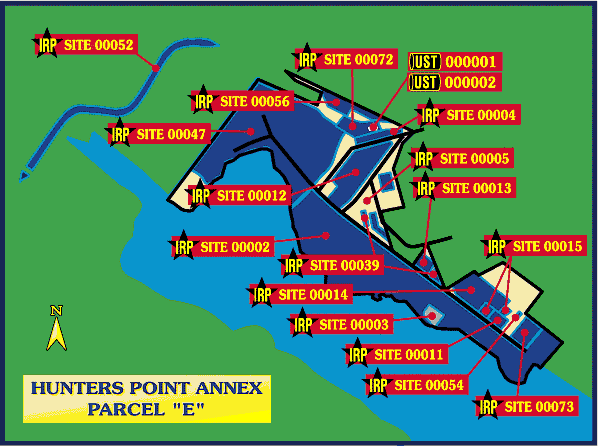|
|
|
SEE MAP AT THE BOTTOM for each of the IR Areas
IR-11 (Building 521 Power Plant)/Group 5/Parcel E
Building 521 is an unpaved area of about 1 acre in the southern portion of HPA on J Street. This structure formerly housed a high-pressure boiler that generated electricity from 1950 to 1969. Steam and fuel lines run between Tank S-505 and the former power plant. Building 521 is no longer in use. Asbestos was used to insulate the steam generation system. There was a 400 to 500 pound mound of insulation outside of Building 521 which was removed in 1990 (23). There are fifteen, 5-gallon cans of xylene, paint, and metal conditioner stored outside the plant.
IR-13 (Old Commissary)/Group 5/Parcel E
The Old Commissary area is 0.7 acres in size and in the southern section of HPA. It is a triangular shaped area bounded by I Street on the east, Manseau Street on the northwest, and J Street on the south. The commissary building was demolished between 1979 and 1978, only the foundation remains (23). One slab of the foundation was turned into a decontamination facility for base RI activities, and is enclosed by a fence. IR-13 was used as a storage yard before construction of the commissary in 1948 or 1949 (23). The remaining area is unpaved. During the Triple A leasing of the HPA, transformers, possibly containing PCBs, were stored on the eastern side of the area (7). Drums of oily dirt were stored at the area; sandblast waste was stored on concrete pads.
IR-14 (Oily Liquid Waste Disposal Area)/Group 5/Parcel E
Northwest of IR-11 and southeast of Building 505, the Oily Liquid Waste, 4.5 acres in size, is in the southern portion of the base. IR-14 is situated between H and J Streets and west of IR-15, the Oily Waste Pond and Incinerator Tank. In an open gully area between Buildings 505 and 521, Triple A reportedly dumped oily liquid waste (7). Later this gully area was filled with sand. The actual location of the gully can not be determined from the existing surface conditions or aerial photographs. Drums, transformers, and chemical canisters may have been disposed of on location. There is no visual evidence of these past disposal activities (22).
IR-15 (Oily Waste Pond and Incineration Tank)/Group 5/Parcel E
The Oily Waste Ponds and Incineration Tank areas are in areas northwest and northeast of IR-11, Building 521. The Oily Liquid Waste Ponds area was a military housing area beginning around 1946; the buildings were torn down in 1976 or 1977 (23). Ponds of oily water were first observed in 1986 by the San Francisco District Attorney (22). Reportedly, a 2.5 inch diameter hose from Tank S-505 (PA-47), south of Building 521, had been used to fill the ponds with waste oils (7). Tank S-505 has been removed. Evidence of these ponds are no longer observable. The area is flat and vegetated. The SWAQAT performed from 1988 to 1989 did not indicate the presence of any landfill gas or surface and subsurface migrations at IR-15 (23).
In the northeast portion of this area, two trash cans, a tank, and a dumpster were seen on 4 April 1986. The tank had been used as an incinerator. The tank, dumpster, and trash cans allegedly contained copper plates, circuit boards, x-ray film, and miscellaneous trash (7). The tank was removed from the area in mid-July 1986 leaving behind visible ground staining (22). The time at which the dumpster and trash can were removed is unknown. All of IR-15 is flat and vegetated.
PA-16 (Container Storage Area, Triple A Area 9)/Group 6/Parcel E
PA-16 is on the eastern corner of H and Mahan Streets and is near the southern tip of HPA. The area is a poorly paved and has a fenced area about 0.2 acres in size. Investigations identified 100 drums labeled "PCB-containing" oil and other drums and containers, transformers, some flammable solids, and a 5,000 gallon tank stored at the area. Neither information concerning the exact contents of these containers, nor methods of disposal are known. Presently no containers, tanks, or drums are stored on location. Some areas are stained (124).
BACK
